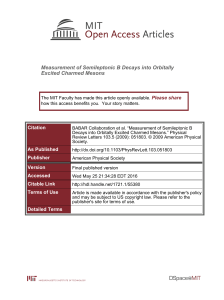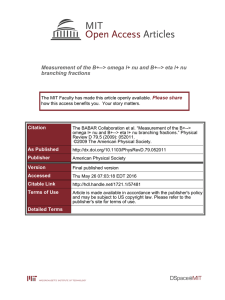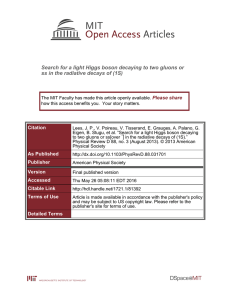Observation of the decay B 0c+p 0 Please share
advertisement
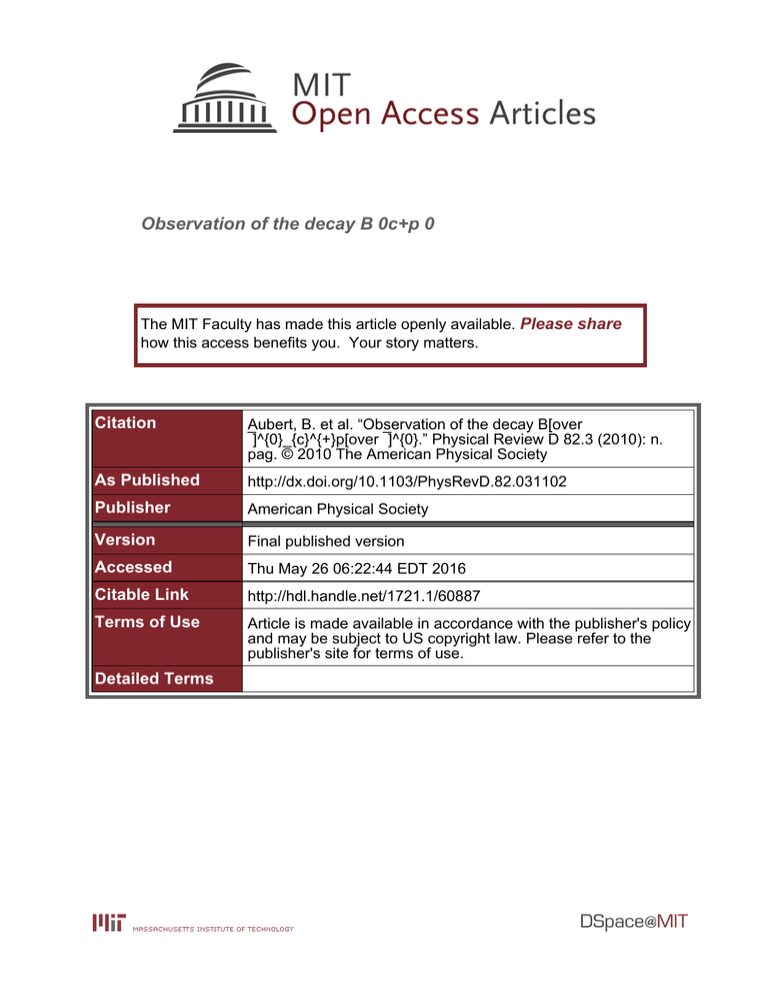
Observation of the decay B 0c+p 0
The MIT Faculty has made this article openly available. Please share
how this access benefits you. Your story matters.
Citation
Aubert, B. et al. “Observation of the decay B[over
¯]^{0}_{c}^{+}p[over ¯]^{0}.” Physical Review D 82.3 (2010): n.
pag. © 2010 The American Physical Society
As Published
http://dx.doi.org/10.1103/PhysRevD.82.031102
Publisher
American Physical Society
Version
Final published version
Accessed
Thu May 26 06:22:44 EDT 2016
Citable Link
http://hdl.handle.net/1721.1/60887
Terms of Use
Article is made available in accordance with the publisher's policy
and may be subject to US copyright law. Please refer to the
publisher's site for terms of use.
Detailed Terms
RAPID COMMUNICATIONS
PHYSICAL REVIEW D 82, 031102(R) (2010)
0
Observation of the decay B 0 ! þ
c p
B. Aubert,1 Y. Karyotakis,1 J. P. Lees,1 V. Poireau,1 E. Prencipe,1 X. Prudent,1 V. Tisserand,1 J. Garra Tico,2 E. Grauges,2
M. Martinelli,3a,3b A. Palano,3a,3b M. Pappagallo,3a,3b G. Eigen,4 B. Stugu,4 L. Sun,4 M. Battaglia,5 D. N. Brown,5
B. Hooberman,5 L. T. Kerth,5 Yu. G. Kolomensky,5 G. Lynch,5 I. L. Osipenkov,5 K. Tackmann,5 T. Tanabe,5
C. M. Hawkes,6 N. Soni,6 A. T. Watson,6 H. Koch,7 T. Schroeder,7 D. J. Asgeirsson,8 C. Hearty,8 T. S. Mattison,8
J. A. McKenna,8 M. Barrett,9 A. Khan,9 A. Randle-Conde,9 V. E. Blinov,10 A. D. Bukin,10,* A. R. Buzykaev,10
V. P. Druzhinin,10 V. B. Golubev,10 A. P. Onuchin,10 S. I. Serednyakov,10 Yu. I. Skovpen,10 E. P. Solodov,10
K. Yu. Todyshev,10 M. Bondioli,11 S. Curry,11 I. Eschrich,11 D. Kirkby,11 A. J. Lankford,11 P. Lund,11 M. Mandelkern,11
E. C. Martin,11 D. P. Stoker,11 H. Atmacan,12 J. W. Gary,12 F. Liu,12 O. Long,12 G. M. Vitug,12 Z. Yasin,12 V. Sharma,13
C. Campagnari,14 T. M. Hong,14 D. Kovalskyi,14 M. A. Mazur,14 J. D. Richman,14 T. W. Beck,15 A. M. Eisner,15
C. A. Heusch,15 J. Kroseberg,15 W. S. Lockman,15 A. J. Martinez,15 T. Schalk,15 B. A. Schumm,15 A. Seiden,15 L. Wang,15
L. O. Winstrom,15 C. H. Cheng,16 D. A. Doll,16 B. Echenard,16 F. Fang,16 D. G. Hitlin,16 I. Narsky,16 P. Ongmongkolkul,16
T. Piatenko,16 F. C. Porter,16 R. Andreassen,17 G. Mancinelli,17 B. T. Meadows,17 K. Mishra,17 M. D. Sokoloff,17
P. C. Bloom,18 W. T. Ford,18 A. Gaz,18 J. F. Hirschauer,18 M. Nagel,18 U. Nauenberg,18 J. G. Smith,18 S. R. Wagner,18
R. Ayad,19,† W. H. Toki,19 E. Feltresi,20 A. Hauke,20 H. Jasper,20 T. M. Karbach,20 J. Merkel,20 A. Petzold,20 B. Spaan,20
K. Wacker,20 M. J. Kobel,21 R. Nogowski,21 K. R. Schubert,21 R. Schwierz,21 D. Bernard,22 E. Latour,22 M. Verderi,22
P. J. Clark,23 S. Playfer,23 J. E. Watson,23 M. Andreotti,24a,24b D. Bettoni,24a C. Bozzi,24a R. Calabrese,24a,24b
A. Cecchi,24a,24b G. Cibinetto,24a,24b E. Fioravanti,24a,24b P. Franchini,24a,24b E. Luppi,24a,24b M. Munerato,24a,24b
M. Negrini,24a,24b A. Petrella,24a,24b L. Piemontese,24a V. Santoro,24a,24b R. Baldini-Ferroli,25 A. Calcaterra,25
R. de Sangro,25 G. Finocchiaro,25 S. Pacetti,25 P. Patteri,25 I. M. Peruzzi,25,‡ M. Piccolo,25 M. Rama,25 A. Zallo,25
R. Contri,26a,26b E. Guido,26a,26b M. Lo Vetere,26a,26b M. R. Monge,26a,26b S. Passaggio,26a C. Patrignani,26a,26b
E. Robutti,26a S. Tosi,26a,26b M. Morii,27 A. Adametz,28 J. Marks,28 S. Schenk,28 U. Uwer,28 F. U. Bernlochner,29
H. M. Lacker,29 T. Lueck,29 A. Volk,29 P. D. Dauncey,30 M. Tibbetts,30 P. K. Behera,31 M. J. Charles,31 U. Mallik,31
J. Cochran,32 H. B. Crawley,32 L. Dong,32 V. Eyges,32 W. T. Meyer,32 S. Prell,32 E. I. Rosenberg,32 A. E. Rubin,32
Y. Y. Gao,33 A. V. Gritsan,33 Z. J. Guo,33 N. Arnaud,34 A. D’Orazio,34 M. Davier,34 D. Derkach,34 J. Firmino da Costa,34
G. Grosdidier,34 F. Le Diberder,34 V. Lepeltier,34 A. M. Lutz,34 B. Malaescu,34 P. Roudeau,34 M. H. Schune,34 J. Serrano,34
V. Sordini,34,x A. Stocchi,34 G. Wormser,34 D. J. Lange,35 D. M. Wright,35 I. Bingham,36 J. P. Burke,36 C. A. Chavez,36
J. R. Fry,36 E. Gabathuler,36 R. Gamet,36 D. E. Hutchcroft,36 D. J. Payne,36 C. Touramanis,36 A. J. Bevan,37 C. K. Clarke,37
F. Di Lodovico,37 R. Sacco,37 M. Sigamani,37 G. Cowan,38 S. Paramesvaran,38 A. C. Wren,38 D. N. Brown,39 C. L. Davis,39
A. G. Denig,40 M. Fritsch,40 W. Gradl,40 A. Hafner,40 K. E. Alwyn,41 D. Bailey,41 R. J. Barlow,41 G. Jackson,41
G. D. Lafferty,41 T. J. West,41 J. I. Yi,41 J. Anderson,42 C. Chen,42 A. Jawahery,42 D. A. Roberts,42 G. Simi,42 J. M. Tuggle,42
C. Dallapiccola,43 E. Salvati,43 R. Cowan,44 D. Dujmic,44 P. H. Fisher,44 S. W. Henderson,44 G. Sciolla,44 M. Spitznagel,44
R. K. Yamamoto,44 M. Zhao,44 P. M. Patel,45 S. H. Robertson,45 M. Schram,45 P. Biassoni,46a,46b A. Lazzaro,46a,46b
V. Lombardo,46a F. Palombo,46a,46b S. Stracka,46a,46b L. Cremaldi,47 R. Godang,47,k R. Kroeger,47 P. Sonnek,47
D. J. Summers,47 H. W. Zhao,47 X. Nguyen,48 M. Simard,48 P. Taras,48 H. Nicholson,49 G. De Nardo,50a,50b L. Lista,50a
D. Monorchio,50a,50b G. Onorato,50a,50b C. Sciacca,50a,50b G. Raven,51 H. L. Snoek,51 C. P. Jessop,52 K. J. Knoepfel,52
J. M. LoSecco,52 W. F. Wang,52 L. A. Corwin,53 K. Honscheid,53 H. Kagan,53 R. Kass,53 J. P. Morris,53 A. M. Rahimi,53
S. J. Sekula,53 N. L. Blount,54 J. Brau,54 R. Frey,54 O. Igonkina,54 J. A. Kolb,54 M. Lu,54 R. Rahmat,54 N. B. Sinev,54
D. Strom,54 J. Strube,54 E. Torrence,54 G. Castelli,55a,55b N. Gagliardi,55a,55b M. Margoni,55a,55b M. Morandin,55a
M. Posocco,55a M. Rotondo,55a F. Simonetto,55a,55b R. Stroili,55a,55b C. Voci,55a,55b P. del Amo Sanchez,56 E. Ben-Haim,56
G. R. Bonneaud,56 H. Briand,56 J. Chauveau,56 O. Hamon,56 Ph. Leruste,56 G. Marchiori,56 J. Ocariz,56 A. Perez,56
J. Prendki,56 S. Sitt,56 L. Gladney,57 M. Biasini,58a,58b E. Manoni,58a,58b C. Angelini,59a,59b G. Batignani,59a,59b
S. Bettarini,59a,59b G. Calderini,59a,59b,{ M. Carpinelli,59a,59b,** A. Cervelli,59a,59b F. Forti,59a,59b M. A. Giorgi,59a,59b
A. Lusiani,59a,59c M. Morganti,59a,59b N. Neri,59a,59b E. Paoloni,59a,59b G. Rizzo,59a,59b J. J. Walsh,59a D. Lopes Pegna,60
C. Lu,60 J. Olsen,60 A. J. S. Smith,60 A. V. Telnov,60 F. Anulli,61a E. Baracchini,61a,61b G. Cavoto,61a R. Faccini,61a,61b
F. Ferrarotto,61a F. Ferroni,61a,61b M. Gaspero,61a,61b P. D. Jackson,61a L. Li Gioi,61a M. A. Mazzoni,61a S. Morganti,61a
G. Piredda,61a F. Renga,61a,61b C. Voena,61a M. Ebert,62 T. Hartmann,62 H. Schröder,62 R. Waldi,62 T. Adye,63 B. Franek,63
E. O. Olaiya,63 F. F. Wilson,63 S. Emery,64 L. Esteve,64 G. Hamel de Monchenault,64 W. Kozanecki,64 G. Vasseur,64
Ch. Yèche,64 M. Zito,64 M. T. Allen,65 D. Aston,65 D. J. Bard,65 R. Bartoldus,65 J. F. Benitez,65 R. Cenci,65 J. P. Coleman,65
M. R. Convery,65 J. C. Dingfelder,65 J. Dorfan,65 G. P. Dubois-Felsmann,65 W. Dunwoodie,65 R. C. Field,65
1550-7998= 2010=82(3)=031102(8)
031102-1
Ó 2010 The American Physical Society
RAPID COMMUNICATIONS
B. AUBERT et al.
PHYSICAL REVIEW D 82, 031102(R) (2010)
65
65
65
65
M. Franco Sevilla, B. G. Fulsom, A. M. Gabareen, M. T. Graham, P. Grenier,65 C. Hast,65 W. R. Innes,65
J. Kaminski,65 M. H. Kelsey,65 H. Kim,65 P. Kim,65 M. L. Kocian,65 D. W. G. S. Leith,65 S. Li,65 B. Lindquist,65 S. Luitz,65
V. Luth,65 H. L. Lynch,65 D. B. MacFarlane,65 H. Marsiske,65 R. Messner,65,* D. R. Muller,65 H. Neal,65 S. Nelson,65
C. P. O’Grady,65 I. Ofte,65 M. Perl,65 B. N. Ratcliff,65 A. Roodman,65 A. A. Salnikov,65 R. H. Schindler,65 J. Schwiening,65
A. Snyder,65 D. Su,65 M. K. Sullivan,65 K. Suzuki,65 S. K. Swain,65 J. M. Thompson,65 J. Va’vra,65 A. P. Wagner,65
M. Weaver,65 C. A. West,65 W. J. Wisniewski,65 M. Wittgen,65 D. H. Wright,65 H. W. Wulsin,65 A. K. Yarritu,65
C. C. Young,65 V. Ziegler,65 X. R. Chen,66 H. Liu,66 W. Park,66 M. V. Purohit,66 R. M. White,66 J. R. Wilson,66 M. Bellis,67
P. R. Burchat,67 A. J. Edwards,67 T. S. Miyashita,67 S. Ahmed,68 M. S. Alam,68 J. A. Ernst,68 B. Pan,68 M. A. Saeed,68
S. B. Zain,68 A. Soffer,69 S. M. Spanier,70 B. J. Wogsland,70 R. Eckmann,71 J. L. Ritchie,71 A. M. Ruland,71
C. J. Schilling,71 R. F. Schwitters,71 B. C. Wray,71 B. W. Drummond,72 J. M. Izen,72 X. C. Lou,72 F. Bianchi,73a,73b
D. Gamba,73a,73b M. Pelliccioni,73a,73b M. Bomben,74a,74b L. Bosisio,74a,74b C. Cartaro,74a,74b G. Della Ricca,74a,74b
L. Lanceri,74a,74b L. Vitale,74a,74b V. Azzolini,75 N. Lopez-March,75 F. Martinez-Vidal,75 D. A. Milanes,75 A. Oyanguren,75
J. Albert,76 Sw. Banerjee,76 B. Bhuyan,76 H. H. F. Choi,76 K. Hamano,76 G. J. King,76 R. Kowalewski,76 M. J. Lewczuk,76
I. M. Nugent,76 J. M. Roney,76 R. J. Sobie,76 T. J. Gershon,77 P. F. Harrison,77 J. Ilic,77 T. E. Latham,77
G. B. Mohanty,77 E. M. T. Puccio,77 H. R. Band,78 X. Chen,78 S. Dasu,78 K. T. Flood,78 Y. Pan,78 R. Prepost,78
C. O. Vuosalo,78 and S. L. Wu78
(BABAR Collaboration)
1
Laboratoire d’Annecy-le-Vieux de Physique des Particules (LAPP), Université de Savoie,
CNRS/IN2P3, F-74941 Annecy-Le-Vieux, France
2
Universitat de Barcelona, Facultat de Fisica, Departament ECM, E-08028 Barcelona, Spain
3a
INFN Sezione di Bari, I-70126 Bari, Italy
3b
Dipartimento di Fisica, Università di Bari, I-70126 Bari, Italy
4
University of Bergen, Institute of Physics, N-5007 Bergen, Norway
5
Lawrence Berkeley National Laboratory and University of California, Berkeley, California 94720, USA
6
University of Birmingham, Birmingham, B15 2TT, United Kingdom
7
Ruhr Universität Bochum, Institut für Experimentalphysik 1, D-44780 Bochum, Germany
8
University of British Columbia, Vancouver, British Columbia, Canada V6T 1Z1
9
Brunel University, Uxbridge, Middlesex UB8 3PH, United Kingdom
10
Budker Institute of Nuclear Physics, Novosibirsk 630090, Russia
11
University of California at Irvine, Irvine, California 92697, USA
12
University of California at Riverside, Riverside, California 92521, USA
13
University of California at San Diego, La Jolla, California 92093, USA
14
University of California at Santa Barbara, Santa Barbara, California 93106, USA
15
University of California at Santa Cruz, Institute for Particle Physics, Santa Cruz, California 95064, USA
16
California Institute of Technology, Pasadena, California 91125, USA
17
University of Cincinnati, Cincinnati, Ohio 45221, USA
18
University of Colorado, Boulder, Colorado 80309, USA
19
Colorado State University, Fort Collins, Colorado 80523, USA
20
Technische Universität Dortmund, Fakultät Physik, D-44221 Dortmund, Germany
21
Technische Universität Dresden, Institut für Kern- und Teilchenphysik, D-01062 Dresden, Germany
22
Laboratoire Leprince-Ringuet, CNRS/IN2P3, Ecole Polytechnique, F-91128 Palaiseau, France
23
University of Edinburgh, Edinburgh EH9 3JZ, United Kingdom
24a
INFN Sezione di Ferrara, I-44100 Ferrara, Italy
24b
Dipartimento di Fisica, Università di Ferrara, I-44100 Ferrara, Italy
25
INFN Laboratori Nazionali di Frascati, I-00044 Frascati, Italy
26a
INFN Sezione di Genova, I-16146 Genova, Italy
26b
Dipartimento di Fisica, Università di Genova, I-16146 Genova, Italy
27
Harvard University, Cambridge, Massachusetts 02138, USA
28
Universität Heidelberg, Physikalisches Institut, Philosophenweg 12, D-69120 Heidelberg, Germany
29
Humboldt-Universität zu Berlin, Institut für Physik, Newtonstr. 15, D-12489 Berlin, Germany
30
Imperial College London, London, SW7 2AZ, United Kingdom
31
University of Iowa, Iowa City, Iowa 52242, USA
32
Iowa State University, Ames, Iowa 50011-3160, USA
33
Johns Hopkins University, Baltimore, Maryland 21218, USA
031102-2
RAPID COMMUNICATIONS
OBSERVATION OF THE DECAY . . .
PHYSICAL REVIEW D 82, 031102(R) (2010)
34
Laboratoire de l’Accélérateur Linéaire, IN2P3/CNRS et Université Paris-Sud 11,
Centre Scientifique d’Orsay, B. P. 34, F-91898 Orsay Cedex, France
35
Lawrence Livermore National Laboratory, Livermore, California 94550, USA
36
University of Liverpool, Liverpool L69 7ZE, United Kingdom
37
Queen Mary, University of London, London, E1 4NS, United Kingdom
38
University of London, Royal Holloway and Bedford New College, Egham, Surrey TW20 0EX, United Kingdom
39
University of Louisville, Louisville, Kentucky 40292, USA
40
Johannes Gutenberg-Universität Mainz, Institut für Kernphysik, D-55099 Mainz, Germany
41
University of Manchester, Manchester M13 9PL, United Kingdom
42
University of Maryland, College Park, Maryland 20742, USA
43
University of Massachusetts, Amherst, Massachusetts 01003, USA
44
Massachusetts Institute of Technology, Laboratory for Nuclear Science, Cambridge, Massachusetts 02139, USA
45
McGill University, Montréal, Québec, Canada H3A 2T8
46a
INFN Sezione di Milano, I-20133 Milano, Italy
46b
Dipartimento di Fisica, Università di Milano, I-20133 Milano, Italy
47
University of Mississippi, University, Mississippi 38677, USA
48
Université de Montréal, Physique des Particules, Montréal, Québec, Canada H3C 3J7
49
Mount Holyoke College, South Hadley, Massachusetts 01075, USA
50a
INFN Sezione di Napoli, I-80126 Napoli, Italy
50b
Dipartimento di Scienze Fisiche, Università di Napoli Federico II, I-80126 Napoli, Italy
51
NIKHEF, National Institute for Nuclear Physics and High Energy Physics, NL-1009 DB Amsterdam, The Netherlands
52
University of Notre Dame, Notre Dame, Indiana 46556, USA
53
Ohio State University, Columbus, Ohio 43210, USA
54
University of Oregon, Eugene, Oregon 97403, USA
55a
INFN Sezione di Padova, I-35131 Padova, Italy
55b
Dipartimento di Fisica, Università di Padova, I-35131 Padova, Italy
56
Laboratoire de Physique Nucléaire et de Hautes Energies, IN2P3/CNRS, Université Pierre et Marie Curie-Paris6,
Université Denis Diderot-Paris7, F-75252 Paris, France
57
University of Pennsylvania, Philadelphia, Pennsylvania 19104, USA
58a
INFN Sezione di Perugia, I-06100 Perugia, Italy
58b
Dipartimento di Fisica, Università di Perugia, I-06100 Perugia, Italy
59a
INFN Sezione di Pisa, I-56127 Pisa, Italy
59b
Dipartimento di Fisica, Università di Pisa, I-56127 Pisa, Italy
59c
Scuola Normale Superiore di Pisa, I-56127 Pisa, Italy
60
Princeton University, Princeton, New Jersey 08544, USA
61a
INFN Sezione di Roma, I-00185 Roma, Italy
61b
Dipartimento di Fisica, Università di Roma La Sapienza, I-00185 Roma, Italy
62
Universität Rostock, D-18051 Rostock, Germany
63
Rutherford Appleton Laboratory, Chilton, Didcot, Oxon, OX11 0QX, United Kingdom
64
CEA, Irfu, SPP, Centre de Saclay, F-91191 Gif-sur-Yvette, France
65
SLAC National Accelerator Laboratory, Stanford, California 94309 USA
66
University of South Carolina, Columbia, South Carolina 29208, USA
67
Stanford University, Stanford, California 94305-4060, USA
68
State University of New York, Albany, New York 12222, USA
69
Tel Aviv University, School of Physics and Astronomy, Tel Aviv, 69978, Israel
70
University of Tennessee, Knoxville, Tennessee 37996, USA
71
University of Texas at Austin, Austin, Texas 78712, USA
72
University of Texas at Dallas, Richardson, Texas 75083, USA
73a
INFN Sezione di Torino, I-10125 Torino, Italy
73b
Dipartimento di Fisica Sperimentale, Università di Torino, I-10125 Torino, Italy
74a
INFN Sezione di Trieste, I-34127 Trieste, Italy
74b
Dipartimento di Fisica, Università di Trieste, I-34127 Trieste, Italy
*Deceased.
†
Now at Temple University, Philadelphia, Pennsylvania 19122, USA.
‡
Also with Università di Perugia, Dipartimento di Fisica, Perugia, Italy.
x
Also with Università di Roma La Sapienza, I-00185 Roma, Italy.
k
Now at University of South Alabama, Mobile, Alabama 36688, USA.
{
Also with Laboratoire de Physique Nucléaire et de Hautes Energies, IN2P3/CNRS, Université Pierre et Marie Curie-Paris6,
Université Denis Diderot-Paris7, F-75252 Paris, France.
**Also with Università di Sassari, Sassari, Italy.
031102-3
RAPID COMMUNICATIONS
B. AUBERT et al.
PHYSICAL REVIEW D 82, 031102(R) (2010)
75
IFIC, Universitat de Valencia-CSIC, E-46071 Valencia, Spain
University of Victoria, Victoria, British Columbia, Canada V8W 3P6
77
Department of Physics, University of Warwick, Coventry CV4 7AL, United Kingdom
78
University of Wisconsin, Madison, Wisconsin 53706, USA
(Received 12 July 2010; published 25 August 2010)
76
In a sample of 467 106 BB pairs collected with the BABAR detector at the PEP-II collider at SLAC
0 and measured the branching fraction to be ð1:94 0:17 we have observed the decay B 0 ! þ
c p
4
0:14 0:50Þ 10 , where the uncertainties are statistical, systematic, and the uncertainty on the þ
c !
pK þ branching fraction, respectively. We determine an upper limit of 1:5 106 at 90% C.L. for the
þ
Bðþ
product branching fraction BðB 0 ! þ
c ð2455ÞpÞ
c ! pK Þ. Furthermore, we observe an
enhancement at the threshold of the invariant mass of the baryon-antibaryon pair.
DOI: 10.1103/PhysRevD.82.031102
PACS numbers: 13.25.Hw, 13.60.Rj
Although approximately 7% of B-meson decays have
baryons in the final state, presently the sum of all measured
branching fractions of exclusive baryonic B decays is only
about 1% [1]. B mesons decay dominantly via b ! c
transitions, hence decays to baryons should be dominated
by charm baryon production or a charmed meson accompanied by noncharmed baryons. Both types of decays have
been observed [2,3], and are found to have comparable
branching fractions for decays to final states with the same
multiplicity.
In baryonic B decays and in baryon production in general, enhancements at the threshold for the baryonantibaryon invariant mass have been observed [3,4]. This
may indicate resonances near threshold or another mechanism for enhanced production of baryon-antibaryon pairs.
This threshold enhancement may also explain the increase
in branching fraction with final-state multiplicity and the
apparent suppression of two-body decays to baryons [1,5].
The mechanisms of baryon production in heavy meson
decays are poorly understood, and studies of exclusive
decays may provide insight into different decay mechanisms. As will be discussed below, isospin relations will
also help distinguish different primary processes.
In this paper, we present a study of the decay B 0 !
þ
0 [6] and measure its branching fraction. The CLEO
c p
collaboration previously set an upper limit of BðB 0 !
0 Þ < 5:9 104 based on an integrated luminosity
þ
c p
of 2:39 fb1 [7]. For the isospin-related decay, B !
, several measurements of the branching fraction
þ
c p
have been performed [8,9]. The recent BABAR measurement gives ð3:38 0:12 0:12 0:88Þ 104 [10], a
value that is significantly higher than earlier measurements
(4:3 deviation). The last and dominant error is due to the
þ
uncertainty in the þ
c ! pK branching fraction, common to all measurements.
final-state can only have an
While the B ! þ
c p
0
0 can also have I ¼ 1=2. If
isospin I of 3=2, B ! þ
c p
both decays proceed via the same weak decay mechanism,
I ¼ 3=2, the ratio of the partial decay widths of B 0 to B
should be 2=3. However, it is also possible that the decay
mechanisms are different. Thus a deviation of the ratio of
partial decay widths from 2=3 would suggest a contribution
0 decay or
from the I ¼ 1=2 final-state to the B 0 ! þ
c p
a contribution from the decay process where the is
decay.
coming from the W in the B ! þ
c p
This analysis is based on a data set of about 426 fb1
corresponding to 467 106 BB pairs. These data were
collected with the BABAR detector at the PEP-II
asymmetric-energy
eþ e collider with a center-of-mass
pffiffiffi
energy, s, at the ð4SÞ resonance mass. An additional
sample of 44:5 fb1 , collected 40 MeV below the mass of
the ð4SÞ resonance, are used to study the continuum
where q ¼ u, d, s, or c.
background eþ e ! qq,
The signal efficiency is determined using a detailed
GEANT4 [11] Monte Carlo (MC) simulation of the
BABAR detector that generates MC events uniformly in
0 phase space. MC events are also used to study
the þ
c p
the background contributions.
The BABAR detector is described in detail elsewhere
[12]. Charged particles are distinguished and their momenta measured in the tracking system consisting of a
five-layer double-sided silicon vertex tracker (SVT) and a
40-layer drift chamber (DCH). An internally reflecting ring
imaging Cherenkov detector (DIRC) is also used to distinguish charged particles and a CsI(Tl) electromagnetic
calorimeter (EMC) is used to detect photons.
Likelihood ratios based on information from SVT, DCH
and DIRC are used to identify protons and kaons. The
efficiency for the kaon selection is around 90% while the
rate for misidentifying pions and protons as kaons varies
between 5% and 10%, depending on track momentum. The
identification efficiency for the proton selection is greater
than 90% while the misidentification rate of identifying
kaons and pions as protons varies between 3% and 15%,
depending on track momentum.
Two photons are selected as electromagnetic showers in
the EMC with the expected shape and are combined to
form a 0 candidate, where the photon with the lower
energy must have an energy greater than 60 MeV, while
the second photon must have an energy greater than
100 MeV. The invariant mass of the combination is
required to be between 120 MeV=c2 and 145 MeV=c2 .
031102-4
RAPID COMMUNICATIONS
OBSERVATION OF THE DECAY . . .
PHYSICAL REVIEW D 82, 031102(R) (2010)
The
candidates are reconstructed in the decay mode
þ
þ
!
pK
, and a fit with geometric constraint applied
c
to the common vertex must have a 2 probability greater
than 0.1%. The invariant pK þ mass must be within
2:5 of the fitted peak of the mass distribution, 2:276 <
0
mðpK þ Þ < 2:296 GeV=c2 . The þ
c and candidates
are then combined with a p candidate in a fit using kinematic constraints to form a B 0 candidate. In the fit, the mass
of the pK þ candidate is constrained to the mass of the
þ
c and the mass of the combination to the mass of the
0 [1]. The 2 probability of this fit must be greater than
0.1%.
The analysis makes use of two almost independent
pffiffiffikinematic variables, E and mES , where E ¼ EB s=2 is
the
of the reconstructed energy EB and half of
pffiffiffi difference
þ
s in the e e center-of-mass frame (CMS). The other
qffiffiffiffiffiffiffiffiffiffiffiffiffiffiffiffiffiffiffiffiffiffiffiffiffiffiffiffiffiffiffiffiffiffiffiffiffiffiffiffiffiffiffiffiffiffiffiffiffiffiffiffiffiffi
variable is mES ¼ ðs=2 þ p0 pB Þ2 =E20 p2B where
ðE0 ; p0 Þ is the four momentum of the eþ e system and
pB is the B candidate momentum, both measured in the
laboratory frame. The mES distribution for signal events
peaks at the B mass and the distribution of E for signal
events is centered around zero. Candidates arising from
other B decays, with more final-state particles, such as
þ , are shifted to negative values of E.
B 0 ! þ
c p
Conversely, candidates arising from B decays with fewer
are shifted to
final-state particles, such as B 0 ! þ
c p,
positive values. To suppress these decays, only candidates
with 50 MeV < E < 40 MeV are selected.
A considerable background comes from B ! þ
c p
0
decays, and, in particular, from the B ! c ð2455Þp,
þ
0c ð2455Þ ! þ
pair from
c decays, in which the c p
B decay is combined with a 0 from the decay of the Bþ
meson. To suppress this background, we reconstruct B !
, and reject the event if jEj < 50 MeV and
þ
c p
mES > 5:27 GeV=c2 for such a B candidate, or if the
2
condition 2400 MeV=c2 < mðþ
c Þ < 2465 MeV=c is
satisfied (veto cuts). These two requirements keep 98% of
the signal, while they remove 85% of B ! 0c ð2455Þp
events. The remaining 15% of the background events do
not peak in the signal E mES region.
The continuum background is reduced by a requirement
on the thrust value of the event T < 0:75, where we include
both charged particles and photons in this calculation. The
thrust is defined as
P ^
jT pi j
i
P
T¼
;
jpi j
from MC simulation and continuum data collected
40 MeV below the ð4SÞ energy.
To further reduce the background from continuum and
BB events, mainly coming from combinations of low
energy, only one B 0 candidate per event is selected. In
events with more than one candidate (about 10% of the
events), first the candidate(s) with the invariant mass
mðÞ closest to the 0 nominal mass are selected. For
events with multiple candidates containing the same 0 ,
the candidate with the pK þ mass closest to the nominal
c mass is retained. If there are still multiple B candidates,
the candidate with the highest probability of the kinematic
vertex fit is used. Figure 1 shows a comparison between the
E distribution of candidates reconstructed in data and in
signal MC events, in which signal events are obtained by a
fit to the mES distribution in every E bin, as described
below.
The number of reconstructed signal candidates is determined from a binned 2 fit to the observed mES distribution
shown in Fig. 2. The sum of two Gaussian distributions
with different means is used to describe the signal. The
parameters of the two Gaussians are fixed to the
values obtained from a fit to signal MC events. The background is described by the function [13] fbg ¼
pffiffiffiffiffiffiffiffiffiffiffiffiffiffiffiffiffiffiffiffiffiffiffiffiffiffiffiffiffiffiffiffi
2
n mES 1 ðmES =m0 Þ2 ecð1ðmES =m0 Þ Þ , where m0 ¼
2
5:289 GeV=c is the kinematic end-point value, c a shape
parameter left free in the fit, and n is the normalization.
There are 273 23 signal candidates seen in data and the
significance of this observation is more than 10.
The number of produced signal events used to measure
the branching fraction is determined by a fit to the
efficiency-corrected mES distribution using the same parametrization as before. The events are weighted with the
inverse of the efficiency as a function of the invariant mass
40
35
Events/ 8MeV
þ
c
30
25
20
15
10
5
0
(1)
-5
-0.1
i
-0.05
0
0.05
0.1
∆E [GeV]
where T^ is the thrust axis defined as the direction which
maximizes the sum of the longitudinal momenta of the
particles, and pi the momentum vector of the i-th particle
in the CMS. This selection keeps 83% of the signal but
only 25% of the continuum background, as determined
FIG. 1 (color online). E distribution for data signal events
after all selection cuts (data points) and signal MC events
(histogram) normalized to the number of data signal events;
signal events are obtained from binwise mES fits; dashed lines
show the range used for mES distributions.
031102-5
RAPID COMMUNICATIONS
B. AUBERT et al.
χ2 / ndf = 76 / 86
60
Events/1 MeV/c2
PHYSICAL REVIEW D 82, 031102(R) (2010)
50
40
30
20
10
0
5.2
5.21
5.22
5.23
5.24
5.25
5.26
5.27
5.28
5.29
5.3
mES [GeV/c2]
FIG. 2. Fitted mES distribution without efficiency correction
(data points); the result of the fit (solid line) and the background
estimate (dashed line) is shown.
0
mðþ
c Þ. To compute the efficiency, the signal MC sam0
ple is divided in 10 intervals of mðþ
c Þ. For each interval
the mES distribution is fitted to extract the signal MC yield.
The efficiency for each interval is computed dividing the
yield by the number of events generated in this interval.
The resulting efficiency distribution is then fitted by a 4th
order polynomial. The averaged signal efficiency is 6.0%.
The weighted data mES distribution is shown in Fig. 3,
and the fit found 4528 403 signal events (Nsignal ). The
branching fraction is then calculated as
0Þ ¼
BðB 0 ! þ
c p
Nsignal
þ Þ 2N 0 0
Bðþ
!
pK
c
B B
¼ ð1:94 0:17Þ 104 ;
(2)
where the uncertainty is statistical only from the fit, and
þ
Bðþ
c ! pK Þ ¼ ð0:050 0:013Þ [1]. The quantity
NB0 B 0 ¼ ð233:6 2:6Þ 106 is the number of B0 B 0 pairs
and Bðð4SÞ ! B0 B 0 Þ ¼ 0:5 is assumed.
To check for peaking background from other B decays
and random combinations, the analysis is repeated for
selected samples without mass constraints on the 0 and
þ
c mass. The signal yields after subtraction of background
obtained from the invariant mass distributions of the 0
and þ
c are found to be consistent with the default analysis.
The systematic uncertainties are mainly derived from
studies of data control samples and by comparison of data
and MC events. The main systematic uncertainty arises
from differences between data and MC events in the E
distribution seen in Fig. 1. The difference between the cut
efficiency in MC and data, relative to the MC one, is used
as the systematic uncertainty (4.6%). Other systematic
uncertainties arise from the veto cuts (3.4%), the 0 reconstruction efficiency (3.0%), the particle identification
(1.2%), the number of B0 B 0 pairs (1.1%) and the reconstruction efficiency of charged tracks (0.9%). To determine
the uncertainty from the MC model we use to generate
signal events, these signal events are reweighted depending
0 Þ, and a new efficiency function is calculated.
on mðp
The data mES distribution is then corrected for reconstruction efficiencies with this function and fitted as before. The
difference in the number of signal events we use as the
systematic uncertainty of the specific MC model (2.2%).
The systematic uncertainty due to the fit is determined by
changing the cut-off value of the background function by
1 MeV=c2 (0.50%). The individual contributions to the
systematic uncertainty are added in quadrature, resulting
in the total of 7.1%.
distribution is comIn Fig. 4, the measured mðþ
c pÞ
pared with a MC simulated one, generated with a phase
0 and normalized
space distribution for the decay to þ
c p
to the number of data events. To extract the signal distribution events, the mES distribution is fitted in every bin of
There is a clear difference in shape between data
mðþ
c pÞ.
and simulation, with a clear enhancement at low mass, with
1200
Events/ 200MeV/c2
1000
1200
χ2 / ndf = 82 / 86
Events/1 MeV/c2
1000
800
600
400
600
400
200
200
0
5.2
800
0
3.2
5.21
5.22
5.23
5.24
5.25
5.26
5.27
5.28
5.29
mES [GeV/c2]
FIG. 3. Efficiency-corrected mES distribution for B 0 !
0 (data points). The result of the fit (solid line) and the
þ
c p
background estimate (dashed line) is shown.
3.4
3.6
3.8
4
4.2
m(Λ+cp)
5.3
4.4
4.6
4.8
5
5.2
2
[GeV/c ]
FIG. 4 (color online). Efficiency corrected distribution of the
points are signal data events; histogram
invariant mass mðþ
c pÞ;
shows signal MC events assuming phase space distribution
normalized to the number of data events.
031102-6
RAPID COMMUNICATIONS
OBSERVATION OF THE DECAY . . .
PHYSICAL REVIEW D 82, 031102(R) (2010)
0 Þ ¼ ð1:94 0:17 0:14 0:50Þ 104 ;
BðB 0 ! þ
c p
(3)
where the uncertainties are statistical, systematic, and from
þ
þ
the þ
c branching fraction, c ! pK . The ratio of
the partial decay width measured here to the BABAR
[10] is
measurement of the decay B ! þ
c p
0Þ
BðB 0 ! þ
c p
B ¼ 0:61 0:09;
þ B 0
BðB ! c p Þ
(4)
where B and B 0 are the lifetimes of the B mesons. This
ratio is consistent with the isospin expectation of 2=3.
Given that we do not have evidence for a B 0 ! þ
c p
0
contribution, we also compare our B 0 ! þ
p
measurec
ment with only the nonresonant contribution to the B !
decay. We find
þ
c p
7
6
Events/ 5MeV/c2
a significance of 5 for the first bin, assuming Gaussian
statistics. Such an enhancement is seen in many other
baryonic B decays and also in baryon production, such as
eþ e ! [14], which proceeds through different
short-distance processes.
0
In Fig. 5, the invariant mass of the þ
c combination is
shown, fitted by a Gaussian function for a possible
þ 0
þ
c ð2455Þ signal and by the function n ðmðc Þ þ
0
c
½mðc Þ þ mð ÞÞ to describe the nonresonant fraction
of the signal and background using a likelihood fit. The
shape parameters for the Gaussian are fixed to the parameters obtained from simulated events. The fit returns
Nþc ð2455Þ ¼ 3 3 signal events. Therefore, there is no
The reconstruction effievidence for B 0 ! þ
c ð2455Þp.
is ð1:70 0:05Þ%.
ciency for B 0 ! þ
c ð2455Þp
Integrating the likelihood function of the fit parameter
Nþc ð2455Þ 0, we obtain a Bayesian upper limit at 90%
confidence level (C.L.) of BðB 0 ! þ
c ð2455ÞpÞ
þ
6
Bðþ
c ! K p Þ < 1:5 10 .
In conclusion, we have observed the decay B 0 !
þ 0
c p and measured the branching fraction as:
5
4
3
2
1
0
2.42
2.44
2.46
2.48
2.5
m(Λ+cπ0)
2.52
2.54
2.56
2.58
2.6
2
[GeV/c ]
0
FIG. 5. Distribution of the invariant mass of the þ
c system
ð2455Þ
resonance
is
expected;
points
in the region where the þ
c
are for data with mES > 5:272 GeV=c2 , the curve shows the fit.
6
Bðþ
B ðB 0 ! þ
c ð2455ÞpÞ
c ! K pÞ < 1:5 10 :
(6)
The 90% C.L. Bayesian upper limit for the ratio of the
and B !
branching fractions BðB 0 ! þ
c ð2455ÞpÞ
0
c ð2455Þp [10] is
BðB 0 ! þ
c ð2455ÞpÞ
B < 0:73;
0
B 0
BðB ! c ð2455ÞpÞ
(7)
which we compute by integrating the likelihood profile for
the ratio of branching fractions over the positive range. It is
also consistent with the isospin expectation of 2=3.
which is also consistent with the isospin expectation of
2=3.
For the resonant subchannel we calculate a 90% upper
limit of
We are grateful for the excellent luminosity and machine
conditions provided by our PEP-II colleagues, and for the
substantial dedicated effort from the computing organizations that support BABAR. The collaborating institutions
wish to thank SLAC for its support and kind hospitality.
This work is supported by DOE and NSF (USA), NSERC
(Canada), CEA and CNRS-IN2P3 (France), BMBF and
DFG (Germany), INFN (Italy), FOM (The Netherlands),
NFR (Norway), MES (Russia), MICIIN (Spain), STFC
(United Kingdom). Individuals have received support
from the Marie Curie EIF (European Union), the A. P.
Sloan Foundation and the Binational Science Foundation.
[1] C. Amsler et al. (Particle Data Group), Phys. Lett. B 667, 1
(2008).
[2] K. Abe et al. (Belle Collaboration), Phys. Rev. Lett. 89,
151802 (2002).
[3] B. Aubert et al. (BABAR Collaboration), Phys. Rev. D 74,
051101 (2006).
[4] B. Aubert et al. (BABAR Collaboration), Phys. Rev. D 72,
051101 (2005).
[5] W.-S. Hou and A. Soni, Phys. Rev. Lett. 86, 4247 (2001).
[6] Throughout this paper charge conjugate modes are always
0Þ
BðB 0 ! þ
c p
B ¼ 0:80 0:11; (5)
þ B 0
BðB ! c p Þnonresonant
031102-7
RAPID COMMUNICATIONS
B. AUBERT et al.
PHYSICAL REVIEW D 82, 031102(R) (2010)
implied.
[7] X. Fu et al. (CLEO Collaboration), Phys. Rev. Lett. 79,
3125 (1997).
[8] S. A. Dytman et al. (CLEO Collaboration), Phys. Rev. D
66, 091101 (2002).
[9] N. Gabyshev et al. (Belle Collaboration), Phys. Rev. Lett.
97, 242001 (2006).
[10] B. Aubert et al. (BABAR Collaboration), Phys. Rev. D 78,
112003 (2008).
[11] S. Agostinelli et al. (GEANT4 Collaboration), Nucl.
Instrum. Methods Phys. Res., Sect. A 506, 250 (2003).
[12] B. Aubert et al. (BABAR Collaboration), Nucl. Instrum.
Methods Phys. Res., Sect. A 479, 1 (2002).
[13] H. Albrecht et al. (ARGUS Collaboration), Phys. Lett. B
241, 278 (1990).
[14] B. Aubert et al. (BABAR Collaboration), Phys. Rev. D 76,
092006 (2007).
031102-8
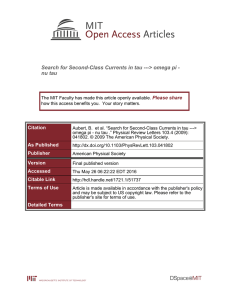
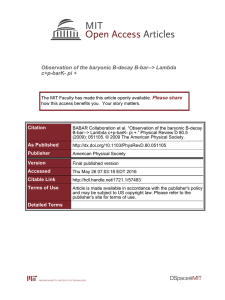
![Observation and polarization measurement of B[superscript 0]-->a1(1260)[superscript +]a1(1260)[superscript -] decay](http://s2.studylib.net/store/data/012120195_1-ffa63fb2f64e70cb6cd5590a52e05bfd-300x300.png)
![Search for B[superscript ±][K[superscript ][superscript](http://s2.studylib.net/store/data/012104788_1-449da01c003119fd79672ecbbafdb55c-300x300.png)
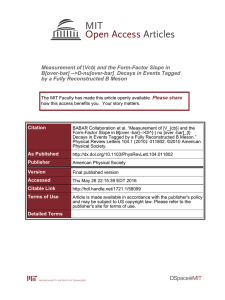
![Observation of the baryonic decay [bar over ]K[superscript +]](http://s2.studylib.net/store/data/012124450_1-001f56a67a858aeb730c0dae2eb8ce7c-300x300.png)
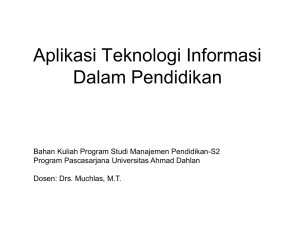
![Measurement of the Branching Fraction and Polarization *0]K[superscript *-]](http://s2.studylib.net/store/data/012104783_1-86c89ecb67d27c9242c62aedfb526f15-300x300.png)
![Measurement of the Branching Fractions and CP Asymmetry of B[superscript -]D[subscript](http://s2.studylib.net/store/data/012104785_1-c23baa81889f8652fe6e8a04107064c5-300x300.png)
